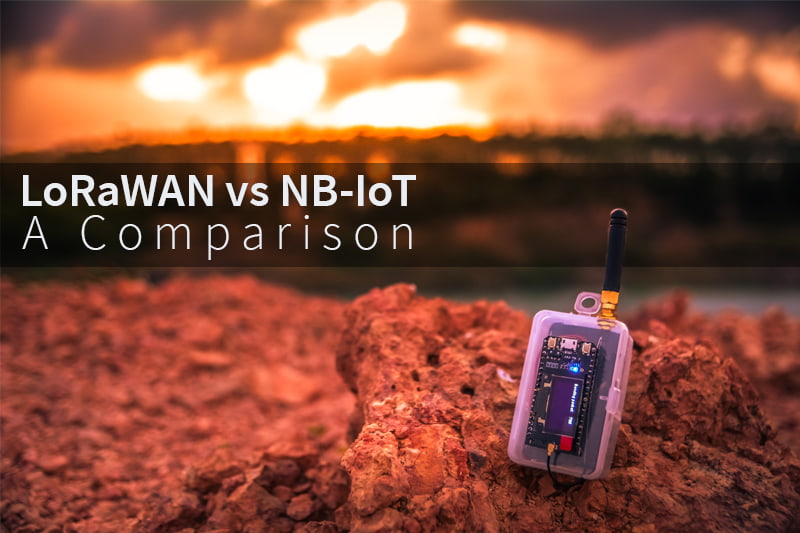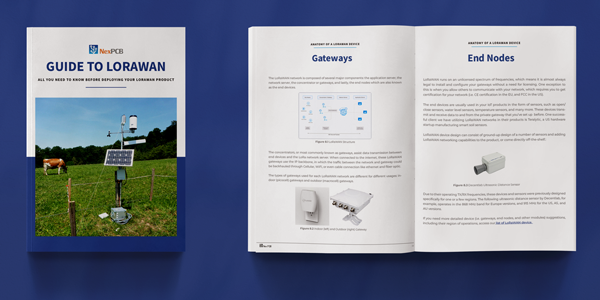LoRaWAN vs NB-IoT: A Comparison
Amidst the development of IoT products, designers often contemplate using two of the most prominent techniques for telecommunication: LoRaWAN and NB-IoT.

Both LoRaWAN (Long Range WAN) and NB-IoT (Narrowband IoT) are types of LPWAN or Low Power Wide Area Networks. LPWAN is a wireless wide area network that interconnects more devices than traditional networks and is known for its long-range capabilities. Like Zigbee, Bluetooth, or WiFi, LPWAN is also commonly used for IoT applications but used specifically on devices operating at low power (i.e. most are battery-powered) and low bandwidth technologies over a larger operating range.
Within the various types of LPWAN available, LoRaWAN and NB-IoT technologies had been two of the most commonly used in hardware IoT applications, particularly due to their excellent coverage range, cost, and power efficiency.
Quoting from the LoRa Alliance, “The LoRaWAN® specification is a Low Power, Wide Area (LPWA) networking protocol designed to wirelessly connect battery operated ‘things’ to the internet in regional, national or global networks, and targets key Internet of Things (IoT) requirements such as bi-directional communication, end-to-end security, mobility and localization services.”
LoRaWAN is a CSS (chirp spread spectrum) technology and operates by a spread spectrum modulation technique. This means the signal generated in the network will be spread over a wide band of frequencies, having its frequency increase and decrease within a certain period -- thus, encoding the information being transferred.
Having been patented by the LoRa Alliance, the LoRaWAN transceiver chips are mainly available from the Semtech Cooperation.
3 Classes of LoRaWAN Transceiver
These transceiver chips came in 3 classes: Class A, with the lowest operational power but highest latency, Class B with moderate operating power and latency, and Class C with the lowest latency but the highest operating power. These different classes of transceiver chips can be used in place of one another or could be used complementary in a device.
NB-IoT, or also known as CAT-NB1 was developed using the 3GPP (3rd Generation Partnership Project) standard -- which also defines standards for 5G systems -- and was designed to enhance the mMTC (Machine Type Communication) / M2M (Machine to machine) technology. NB-IoT runs on the existing licensed LTE (Long Term Evolution) frequency bands and GSM (Global System for Mobile) infrastructures.
The main difference between LoRaWAN and NB-IoT lies in their licensing: LoRaWAN runs on an unlicensed spectrum, while NB-IoT runs on a licensed spectrum. As was discussed earlier, since LoRaWAN is a patented technology, it provides an unlicensed spectrum, which allows users to create private networks for connected devices. Whilst the NB-IoT usually works together with the registered cellular network, which prevents the capability of private network creation but provides end-users with adequate security and encryption.
The frequency range, bandwidth, and data rates of LoRaWAN depend on the area or region its operating in, hence they’re different in the US, Europe, or Asia. On the other hand, NB-IoT technology remains the same throughout different countries, as they are running on the 3GPP standard.
Table of Comparison
|
LoRaWAN |
NB-IoT |
|
|
Modulation |
CSS |
QPSK |
|
Frequency range |
Licensed LTE frequency bands |
|
|
Bandwidth |
150 kHz, 250 kHz |
200 kHz |
|
Range |
5 km (urban), 20 km (rural) |
1 km (urban), 10 km (rural) |
|
Maximum data transmission rate |
50 kbps |
200 kbps |
|
Latency |
Device dependant (Generally higher) |
<10 ms (Generally lower) |
|
Interference immunity |
Very high |
Low |
|
Battery Life |
15+ years |
10+ years |
|
Max. operating current |
32 mA |
120 mA |
|
Sleep current |
1 uA |
5 uA |
|
Handover |
Communicate through gateways, without any base station |
Communication through a single base station, without any gateways |
|
Mobility |
Yes, Class A changes gateway easily |
No, only single handshake possible |
|
Gateway requirement |
Yes |
No |
|
Authentication and encryption |
AES 128-bit |
LTE Encryption (256-bit) |
|
Private network capability |
Yes |
No |
|
Standardization |
LoRa-Alliance |
3GPP |
|
Cost |
Lower |
Higher |
From the comparison table above, it can be deduced that:
- LoRaWAN works in a larger area range than NB-IoT, but both technologies perform well on a longer distance range than traditional LAN (Local Area Network) such as Zigbee, Bluetooth, and WiFi.
- LoRaWAN has a higher interference immunity than NB-IoT, meaning that it would be able to work in crowded environments, i.e. with many furniture, buildings, or trees, and still be able to maintain the connection and the quality of the data packets sent.
- Data transmission speed and size are higher with NB-IoT than LoRaWAN, with also lower latency. Thus, making NB-IoT more reliable for real-time applications.
- With a higher operating and sleep current in NB-IoT applications, its power consumption would generally be higher, impacting its battery life to be shorter than of LoRaWAN’s.
- LoRaWAN allows mobility: ensures devices are connected even when they are on the move, whilst NB-IoT wouldn’t be able to. This is due to the fact that the NB-IoT standard only allows single handshaking between the base station and the end device.
- NB-IoT offers a higher level of protection for data transmission, having a licensed LTE Encryption running on 256-bit data instead of the AES 128-bit system used by LoRaWAN.
- The cost of LoRaWAN products, along with its maintenance and operating costs are lower than that of NB-IoT’s, as NB-IoT would require contracts and licenses from mobile operators registered.
Despite their individual differences, since both LoRaWAN and NB-IoT are both LPWANs, the components to be made available were also similar, such as these open/close door sensors shown in the pictures below:
NB-IoT Open/Close Sensor
LoRaWAN Open/Close Sensor
LoRaWAN is better used for agriculture or environment applications, where data requires a higher refresh rate and where products are operated within a certain distance. Applicating LoRaWAN for customer electronics which focuses on education, entertainment, and other fields where information isn’t too sensitive to be handled would also be a much more appropriate choice rather than using NB-IoT, due to the lower cost and power consumption rate of LoRaWAN.
NB-IoT, on the other hand, will be more reliable to be implemented in smart building systems, security, and traffic management systems, in which real-time and secure data is a priority for operations.
Despite all this, the usage of LoRaWAN and NB-IoT doesn’t necessarily need to work in place of one another -- instead, using both technologies for different tasks in a system would be a much better practice. Using the low-cost privileges of LoRaWAN combined with the enhanced security of NB-IoT would ensure your system performs its best.
Free Resource: Guide to LoRaWAN E-Book

Posted by Nadya Lukman

Nadya is a Mechatronics Engineer who had worked on several different projects including PCU design, engine design, and AI image processing systems. Besides having a little bit of caffeine addiction, she enjoys reading and traveling to new places.

